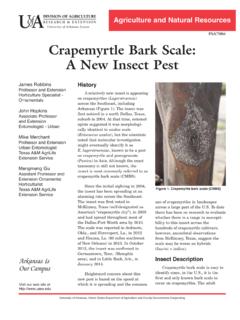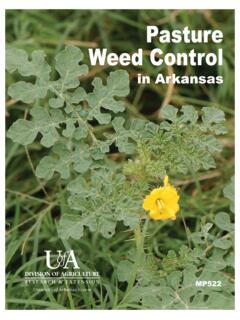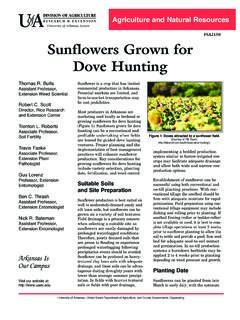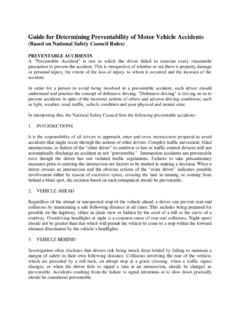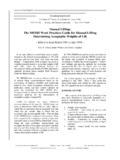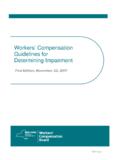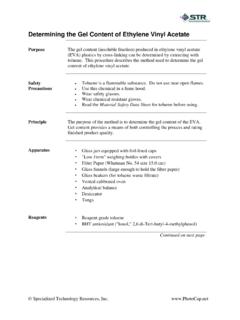Transcription of Landowner’s Guide to Determining Weight and …
1 Agriculture and Natural Resources FSA5017 Landowner s Guide to Determining Weight and Value of Standing Pine Trees David W. Patterson Professor -Wood Science Paul F. Doruska Associate Professor -Forest Measurements, University of Wisconsin -Stevens Point Arkansas Is Our Campus Visit our web site at: Introduction In years past, landowners and foresters could measure a tree and use the Doyle Rule to estimate the num ber of board feet of lumber in the tree. By measuring a sample of trees, the landowner could estimate the volume of lumber that could be cut from the forest stand. By applying the market value to the volume, the value of the standing timber could be determined. Today, the medium of exchange is the outside bark Weight of the timber (dollars per ton) not the board foot volume. Most procurement foresters use a conversion factor to change board feet to pounds or tons.
2 Then the market value for Weight is used to determine the price to offer for the standing timber. The landowner has the problem of Determining his/her own value for the standing timber so they can determine if the price is fair. The objective of this fact sheet is to provide landowners and procure ment foresters with a method of accurately estimating the Weight of standing trees. Research conducted by the Arkansas Forest Resources Center has resulted in equations for accu rately predicting the outside bark Weight of loblolly pine boles (trunks or stems). These equations require only the standard tree measurements. Also, the value of timber is affected by the quality of the trees. This fact sheet will conclude with a discussion of the southern pine tree grading rules to aid the landowner in estimating the quality of standing trees.
3 Option One: Measure Diameter Only This option is predicated on the landowner having only a standard tape measure to determine the size of the tree stem and no way of estima ting the tree height. The tree stem should be measured at a point feet above the ground (breast height). The tape should measure the circum ference of the tree stem in inches. This value can be used in Table 1 or it can be divided by (pi) to provide the diameter (DBH) of the tree stem in inches. If the landowner has a diameter tape (D-tape), it will indicate the diameter directly. Either diameter or circumference can be used with Table 1. If the measurement is between the sizes shown in the table, it can be rounded or the Weight can be interpolated. Table 1 is based upon an equation that accounts for 90 percent of the variation in tree Weight .
4 University of Arkansas, United States Department of Agriculture, and County Governments Cooperating TABLE 1. Outside bark sawlog portion Weight , pulpwood portion Weight and total Weight of loblolly pine boles to a 3-inch top (in pounds) by diameter or circumference at breast height. Diameter Circumference Sawlog Weight Pulpwood Weight Total Weight (inches) (inches) (lbs) (lbs) (lbs) 6 19 0 163 163 7 22 0 294 294 8 25 0 445 445 9 28 0 617 617 10 31 630 162 792 11 35 875 200 1075 12 38 1143 243 1386 13 41 1435 288 1723 14 44 1749 339 2088 15 47 2088 392 2480 16 50 2449 449 2898 17 53 2834 510 3344 18 57 3242 574 3816 19 60 3673 642 4315 20 63 4128 714 4842 21 66 4606 790 5396 22 69 5107 869 5976 23 72 5632 952 6584 24 75 6180 1038 7218 25 79 6752 1128 7880 26 82 7346 1222 8568 27 85 7964 1320 9284 28 88 8605 1421 10026 29 91 9270 1526 10796 30 94 9958 1634 11592 Option Two.
5 Measure Diameter and Height This option is predicated on the landowner having a D-tape for measuring the diameter at breast height (DBH) and an instrument for measuring tree height (for example, a clinometer). Including height increases the accuracy of estimating Weight , and the equations that Tables 2 and 3 are based upon account for 95 to 98 percent of the variation in tree Weight . Table 2 is for pulpwood trees which are 6 to 9 inches in DBH. Table 3 is for sawlog-sized trees with DBH of 10 inches or more. The tables give the Weight in pounds of loblolly pine boles to a 3-inch top. The Weight of trees in Arkansas varies by the season of the year. The values in the tables are the averages for the year. Research at the Arkansas Forest Resources Center has shown that trees are the heaviest in the spring and almost as heavy in the fall.
6 The summer weights are about the yearly average, but in the winter the trees are 6 percent lighter than in the spring and 5 percent lighter than in the fall. Therefore, the table values could be adjusted up 2 or 3 percentage points in the spring and fall and adjusted down 2 or 3 percentage points in the winter. TABLE 2. The Weight in pounds of loblolly pine pulpwood stems to a 3-inch top by DBH and total tree height. DBH Total Tree Height (feet) (inches) 35 40 45 50 55 60 6 158 184 210 238 264 290 7 224 260 296 332 368 404 8 302 348 394 442 488 536 9 388 448 506 566 624 684 TABLE 3. The Weight in pounds of loblolly pine sawlog-sized boles to a 3-inch top by DBH and total tree height. DBH Total Tree Height (feet) (inches) 40 50 60 70 80 90 100 110 120 10 702 808 904 996 1082 11 856 984 1102 1212 1318 12 1024 1176 1318 1450 1576 13 1208 1388 1556 1712 1860 2002 14 1408 1618 1812 1994 2168 2332 15 1866 2090 2300 2500 2690 2872 16 2132 2388 2628 2856 3072 3280 17 2706 2978 3236 3482 3718 3946 18 3046 3352 3642 3920 4184 4440 19 3406 3748 4072 4382 4678 4964 20 3786 4166 4528 4872 5202 5520 21 4188 4608 5008 5388 5754 6104 6444 22 4610 5074 5512 5932 6334 6720 7094 23 5562 6042 6502 6942 7366 7776 24 6072 6598 7100 7586 8044 8490 25 6606 7178 7724 8248 8752 9238 26 7164 7784 8376 8944 9490 10018 27 7744 8416 9054 9668 10258 10830 28 8348 9072 9762 10422 11060 11674 29 8976 9754 10494 11206 11890 12552 30 9626 10460 11256 12018 12752 13462 31 10302 11194 12044 12864 13646 14406 32 11000 11952 12862 13732 14572 15382
7 Quality The term quality is defined in textbooks as aptness for use. Does the object being considered have the properties and attributes necessary for the use for which it is intended? Therefore, quality is in the eye of the user. If the purchaser of timber has a different idea as to quality than the landowner, then the landowner should seek out other buyers or markets. For example, if the landowner has trees with straight, clear boles of good size, then the mar ket to pursue would be companies that manufacture and market 1-inch lumber. High grade 1-inch lumber will sell for two to three times the price of 2-inch lumber of the same grade. How can the landowner deter mine the quality of the trees? The most common way is to use the Forest Service southern pine tree grades. The grades are based on the lowest 16-foot log in the tree.
8 The log starts after a 12-inch stump, but this stump can be raised up to 4 feet if neces sary to avoid fire scar, logging damage, etc. Once the 16-foot section is selected, then it must be divided into four full-length faces. Each face must include one-fourth of the circumference of the tree. The faces may be posi tioned on the tree in any manner, but it is desirable to position the faces so that all of the defects can be placed on the minimum number of faces. The grade for the tree is determined by the number of clear, full-length faces (Table 4). TABLE 4. Determining tree grade by the number of clear faces. Tree Grade Number of Clear Faces A 3 or 4 clear faces B 1 or 2 clear faces C no clear faces As mentioned earlier, quality trees are straight. There is a reduction of one grade for grade A and B trees if (1) sweep in the lower 12 feet of the grading section amounts to 3 inches or more and (2) the amount of sweep is equal to or greater than one-fourth of the DBH.
9 With this fact sheet and the fairly simple measures described, a landowner can estimate the Weight and grade of the trees in his/her stand and subsequently calculate how many tons of grade A tree boles, how many tons of grade B tree boles and how many tons of grade C tree boles are in the stand. If most of the trees are grades A and B and the landowner sells to the correct market, he/she should receive an above-average price for the trees. But if the majority of the trees are grade C, a below-average price offer may be received. Printed by University of Arkansas Cooperative Extension Service Printing Services. DR. DAVID W. PATTERSON is professor - wood science, Issued in furtherance of Cooperative Extension work, Acts of May 8 University of Arkansas Division of Agriculture, Cooperative and June 30, 1914, in cooperation with the Department of Extension Service, and is located at the University of Arkansas at Agriculture, Director, Cooperative Extension Service, University of Monticello, Monticello, Arkansas.
10 DR. PAUL F. DORUSKA is Arkansas. The Arkansas Cooperative Extension Service offers its associate professor - forest measurements, University of Wisconsin -programs to all eligible persons regardless of race, color, national Stevens Point, located at Stevens Point, Wisconsin. origin, religion, gender, age, disability, marital or veteran status, or any other legally protected status, and is an Affirmative FSA5017-PD-4-07N Action/Equal Opportunity Employer.





